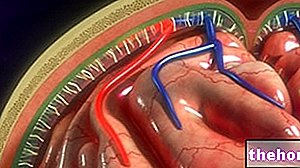Generality
ADEM, also known as acute disseminated encephalomyelitis, is a neurological disease characterized by an inflammation affecting the brain and spinal cord and by a process of demyelination of the nerves of the central nervous system and, sometimes, of the peripheral nervous system.
Most likely, ADEM is an autoimmune condition.

Typical symptoms of ADEM consist of: nausea, vomiting, visual difficulties, confusion, drowsiness, limb weakness, difficulty swallowing, tendency to fall and convulsions.
In the more advanced and severe stages, ADEM can lead to coma.
For a correct diagnosis, the following are essential: physical examination, medical history, magnetic resonance of the brain and lumbar puncture.
Currently, the only treatments available to ADEM patients consist of: two pharmacological therapies, one based on corticosteroids and one based on immunosuppressants and anticancer drugs, and, finally, plasmapheresis.
What is ADEM?
ADEM, or acute disseminated encephalomyelitis, is an autoimmune neurological disease characterized by an inflammatory process affecting the brain and spinal cord and by a demyelinating process of the nerves belonging to the central nervous system and, sometimes, the nervous system peripheral.
EPIDEMIOLOGY
ADEM is a very rare disease; its incidence rate, in fact, is equal to 8 cases per 1,000,000 people per year.
It can arise at any age, however statistical studies have shown that it mainly affects children and adolescents (N.B: subjects between 5 and 8 years are by far the most interested).
ADEM affects males and females more or less equally.
His death rate is 5%.
Causes
Autoimmune diseases are particular morbid conditions characterized by an exaggerated and improper response of the immune system. In fact, in individuals with an autoimmune disease, the cellular and glycoprotein elements, which make up the immune system, recognize some organs and / or tissues of the human body as foreign and, for this reason, attack them; in other words, they act against the organs and / or tissues of the human body as they act against viral, bacterial or fungal agents.
The aggression that the immune system carries out against the organism to be defended involves damage or a more or less substantial alteration of the organs and tissues involved.
In most circumstances, the precise mechanisms that cause an individual's immune system to turn against the organism it is supposed to protect, thus triggering an autoimmune disease, are unclear, if not unknown.
In the specific case of ADEM, it is known that the triggering / favoring factor is, very often, a previous viral or bacterial infection or, more rarely, a previous vaccination. The "ADEM following a" viral or bacterial infection takes the specific name post-infectious ADEM (or acute disseminated post-infectious encephalomyelitis); ADEM following vaccination, on the other hand, takes the specific name of post-vaccination ADEM (or acute disseminated post-vaccination encephalomyelitis).
POST-INFECTIVE ADEM
Post-infectious ADEM affects between 50 and 75% of patients, therefore the majority of clinical cases.
Viruses considered possible triggers of ADEM include: influenza virus, Enterovirus, measles virus, varicella virus, mumps virus, rubella virus, Epstein Barr virus, Cytomegalovirus, Herpes simplex virus, Hepatitis A virus and Coxsackievirus.
As for the post-infectious bacterial ADEM, the bacteria potentially capable of causing it are: Mycoplasma pneumoniae, beta hemolytic streptococcus, bacteria of the genus Leptospira And Borrelia burgdorferi (bacterium responsible for Lyme disease).
POST-VACCINE ADEM
Post-vaccination ADEM affects only a few patients; it is therefore very rare.
Among the vaccinations from which this particular form of ADEM can derive, the following stands out:
- The anti-rabies vaccine (ie, against rabies) of the Semple type, no longer in use;
- Vaccines for hepatitis B, whooping cough, diphtheria, mumps, measles, rubella, pneumococcal pneumonia, chicken pox, Japanese encephalitis and polio.
To avoid misinterpretations, it should be emphasized that the aforementioned vaccines are implicated in the appearance of ADEM only on very rare occasions; giving it up for fear of ADEM exposes the person concerned to risks for good health and life that are certainly higher.
PATHOLOGICAL ANATOMY
From the observation of the central nervous system organs of patients with ADEM it emerged that the inflammatory lesions mainly affect the subcortical and central white matter of both the cerebral hemispheres, the cerebellum, the brainstem and the spinal cord.
Symptoms, signs and complications
Typically, the typical symptoms of post-infectious ADEM appear 1-3 weeks after the triggering infection and consist of:
- Fever;
- Nausea;
- He retched;
- Confusion;
- Visual problems (eg: blurred vision or double vision);
- Drowsiness;
- Weakness in the arms and / or legs;
- Tendency to fall
- Difficulty swallowing
- Convulsions.
As for the classic symptoms of post-vaccination ADEM, these appear from 1 to 3 months after the offending vaccination and consist of:
- Nausea;
- He retched;
- Visual difficulties (ex: blurred vision or double vision);
- Confusion;
- Drowsiness;
- Weakness in the arms and / or legs;
- Difficulty swallowing
- Tendency to fall
- Convulsions.
OTHER SYMPTOMS OF ADEM
In addition to the above symptoms, ADEM can be responsible for: hemiparesis, paraparesis and cranial nerve palsy.
COMPLICATIONS
At the most advanced stages and without adequate medical intervention, ADEM can lead to coma.
Diagnosis
To arrive at a correct diagnosis of ADEM, the following are essential:
- The physical examination;
- The anamnesis. The information it can provide is essential to understand if an ADEM is post-infectious or post-vaccine;
- The magnetic resonance of the brain. It allows to see the consequences of the inflammatory processes affecting the white matter;
- Lumbar puncture with consequent analysis of the cerebrospinal fluid. This test allows to distinguish ADEM from the more known and common multiple sclerosis, whose symptoms are largely overlapping.
Therapy
The availability of treatments for ADEM is very limited, since, up to now, investments aimed at finding adequate treatments and new therapeutic remedies have always been very limited.
Currently, the only treatments available to ADEM patients consist of: a drug therapy based on corticosteroids, a second drug therapy based on immunosuppressants and anticancer drugs and, finally, plasmapheresis.
CORTICOSTEROID-BASED THERAPY
Corticosteroids are powerful anti-inflammatories, ie drugs that act against the processes of inflammation.
Their prolonged or reckless use can have serious repercussions on the health of the human organism and lead, for example, to the onset of: osteoporosis, diabetes, cataracts or obesity.
In the presence of ADEM, the use of corticosteroids is the first line treatment.
Initially, the therapy in question takes place intravenously and involves high pharmacological doses; among the corticosteroids most used in this phase, methylprednisolone and dexamethasone are reported.
Then, after 3-6 weeks, drug administration becomes oral and involves low doses of prednisolone.
According to some statistical surveys, patients who use methylprednisolone would obtain greater benefits, compared to patients who resort to dexamethasone.
Corticosteroids
- Intravenous methylprednisolone and dexamethasone, in high doses;
- Prednisolone by mouth, in low doses.
Immunosuppressants
- Intravenous immunoglobulins
Anticancer drugs
- Intravenous Mitoxantrone;
- Cyclophosphamide.
Plasma exchange
It allows to remove part of the immune cells responsible for the inflammatory state.
Prognosis
According to various medical investigations, the prognosis in case of ADEM:
- It is favorable in most cases (even more than 70% of patients), with a recovery of neurological functions that can be complete or semi-complete. By semi-complete s "he means that some disabilities remain, motor (eg: ataxia or hemiparesis) and / or cognitive (eg: short-term amnesia or loss of attention);
- It is highly unfavorable for at least 5%, which is equivalent to the mortality rate.
It is a fact that the negative prognosis in the case of ADEM largely depends on the lack of treatment with corticosteroids.
Lastly, it should be noted that children with ADEM have greater hopes of enjoying a favorable prognosis than adults.



























